
An autogyro, also known as a gyroplane, is a type of rotorcraft that uses an unpowered rotor in free autorotation to develop lift. Forward thrust is provided independently, by an engine-driven propeller. While similar to a helicopter rotor in appearance, the autogyro's rotor must have air flowing across the rotor disc to generate rotation, and the air flows upwards through the rotor disc rather than down.

Juan de la Cierva y Codorníu, 1st Count of la Cierva was a Spanish civil engineer, pilot and a self taught aeronautical engineer. His most famous accomplishment was the invention in 1920 of a rotorcraft called Autogiro, a single-rotor type of aircraft that came to be called autogyro in the English language. In 1923, after four years of experimentation, De la Cierva developed the articulated rotor, which resulted in the world's first successful flight of a stable rotary-wing aircraft, with his C.4 prototype.
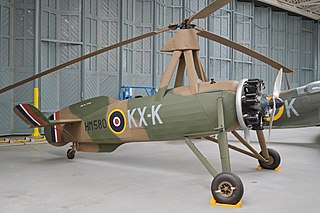
The Cierva C.30 is an autogyro designed by Juan de la Cierva and built under licence from the Cierva Autogiro Company by A V Roe & Co Ltd (Avro), Lioré-et-Olivier and Focke-Wulf.

A rotorcraft or rotary-wing aircraft is a heavier-than-air aircraft with rotary wings or rotor blades, which generate lift by rotating around a vertical mast. Several rotor blades mounted on a single mast are referred to as a rotor. The International Civil Aviation Organization (ICAO) defines a rotorcraft as "supported in flight by the reactions of the air on one or more rotors".
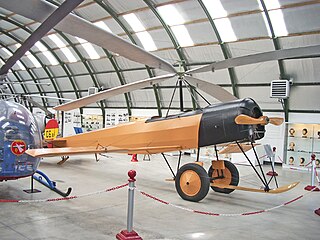
The Cierva C.6 was the sixth autogyro designed by engineer Juan de la Cierva, and the first one to travel a "major" distance. Cierva, the engineer responsible for the invention of the autogyro, had spent all his funds on the research and creation of his first five prototypes. Therefore, in 1923, he turned to the Cuatro Vientos Aerodynamics Laboratory chief, Commander Emilio Herrera, who succeeded in persuading General Francisco Echagüe, the director of the Military Aviation Aeronautics Department, to take over the second stage in the research and development of Cierva's autogyros.

The Pitcairn OP-1 was the first rotary-wing aircraft to be seriously evaluated by any of the world's major air forces. The machine was not a helicopter, nor an airplane, but an autogyro. Pitcairn's model was never put into production for any military.

The Fairey FB-1 Gyrodyne is an experimental British rotorcraft that used single lifting rotor and a tractor propeller mounted on the tip of the starboard stub wing to provide both propulsion and anti-torque reaction.
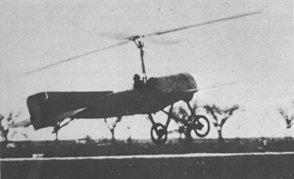
The Cierva C.4 was an experimental autogiro built by Juan de la Cierva in Spain in 1922 which early the following year became the first autogyro to fly successfully. Failures of De la Cierva's attempts to compensate for dissymmetry of lift with the C.1, C.2, and C.3 autogiros, led him to consider alternate means of enabling an autogyro to fly without rolling over. He noted that the problems experienced with his full-size aircraft were not present in the models that he had successfully flown, and considered the difference between the full-size and small-scale rotors. The rotors used on his model were made of bamboo and were thus far more flexible than the ones on his full-size aircraft. While attending an opera he realized that the flexibility eliminated the moments acting on the hub and associated instability. Trained as a civil engineer, Cierva was aware that a cantilever structure hinged to its attachment point generated no moment, and he designed a rotor the blades of which were mounted to the hub through hinges to permit their vertical oscillation.

The Cierva C.8 was an experimental autogyro built by Juan de la Cierva in England in 1926 in association with Avro. Like Cierva's earlier autogyros, the C.8s were based on existing fixed-wing aircraft fuselages – in this case, the Avro 552.
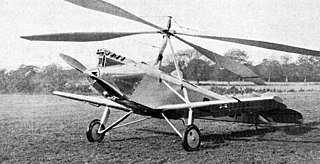
The Cierva C.17 was a British experimental autogyro built by Cierva Autogiro Company in England in 1928, in association with Avro. It was an attempt to build upon the successful Cierva C.8 design using the smaller, more streamlined fuselage of an Avro Avian IIIA as a starting point. The type was found to be underpowered, and when the first attempt at fitting a more powerful engine still did not result in acceptable performance, the design was abandoned.

The Cierva C.19 was a 1930s British two-seat autogyro, designed by Spanish engineer Juan de la Cierva. It was built by Avro as the Avro Type 620. It proved to be the most successful and widely produced of the early de la Cierva designs.

The Kellett KD-1 was a 1930s American autogyro built by the Kellett Autogiro Company. It had the distinction of being the first practical rotary-wing aircraft used by the United States Army and inaugurated the first scheduled air-mail service using a rotary-wing aircraft.

The de Havilland C.24 was a two-seat autogyro built by de Havilland at its Stag Lane works in England in 1931

The Pitcairn PA-34 and Pitcairn PA-33, given the United States Navy (USN) designation Pitcairn OP-2 and United States Army designation Pitcairn YG-2 respectively were reconnaissance autogyros designed and built in 1936 for evaluation.

The Little Wing Autogyro is a series of conventional one and two place autogyros with a tractor engine layout using modern engines and produced by Little Wing Autogyros, Inc. of Mayflower, Arkansas.

The Bernard H.V.120 was a 1930s French racing seaplane designed and built by Bernard to compete in the Schneider Trophy race. Delays caused by engine problems and the crash of the second aircraft delayed entry and the aircraft did not race in the competition.
The Cierva C.29 was a five-seat British cabin autogyro built in 1934 as a joint venture between Westland Aircraft and Cierva. The rotor system and rotors were designed by Cierva and the fuselage by Westland. It was powered by a 600 hp (447 kW) Armstrong Siddeley Panther II engine with a two-bladed tractor propeller; the engine also drove the three-bladed rotor via a clutched shaft. The C.29 suffered from ground resonance during ground running and was not flown. It was later acquired for evaluation by the Royal Aircraft Establishment but it was unable to cure the resonance problem and the autogyro was scrapped in 1939.
The Westland CL.20 was a two-seat autogyro designed and built by Westland Aircraft between 1934 and 1938. One flying prototype and six airframes were built, which had control problems and insufficient lift. Before these problems could be solved the programme was abandoned and the prototype was scrapped in 1938.
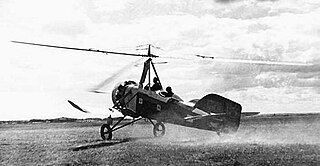
The TsAGI A-4, sometimes anglicised as CAHI A-4 or ZAGI A-4, was an early Russian autogyro, influenced by Cierva designs and delivered in small numbers to the Soviet Air Force in 1934.

The 1933 experimental Pitcairn PA-22 was one of the first wingless autogyros. It was controlled by movement of the rotor plane rather than the usual control surfaces, though initially the much modified lone example retained rudders as a precaution.


















